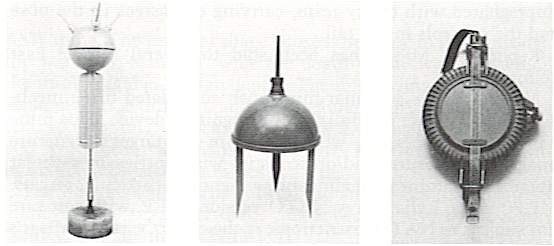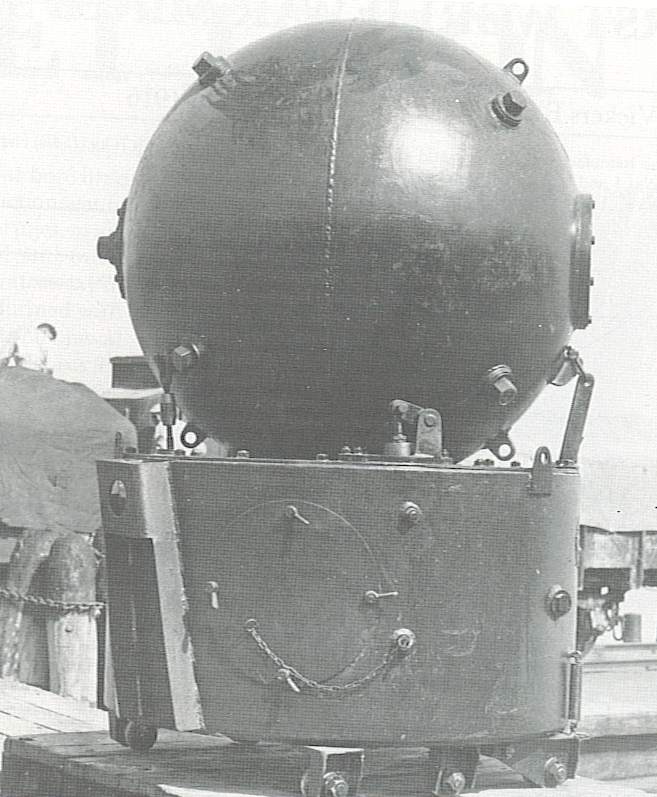Most mines of World War II were Hertz horned type, with the horns containing acid. Contact with the horn broke open the acid container which energized a battery and exploded the mine. During the war antenna and magnetic mines were produced.
Explosives were primarily TNT or TNT with up to 50% cyclonite, but other explosives were also used as an emergency measure during World War II.
The weak nature of the Italian economy did not allow as large a mining campaign as desired, but the Italians did lay some 54,457 during the war.
Italian mines sank one light cruiser (HMS Neptune), three destroyers, eleven submarines and seventeen smaller warships and merchantmen.
Invented by Captain G. Elia of the Italian Navy, this mine used a long lever. When struck by a ship, the lever rotated and detonated the mine. Manufactured before and during the war and a variation was used by the British. Weight 1,676 lbs. (760 kg) with a charge of 320 lbs. (145 kg).
Sautter-Harlé type with 220 lbs. (100 kg) charge and 330 foot (100 m) mooring cable.
Designed to be laid by submarines X2 and X3. Manufactured by San Giorgio Workshops and used until September 1940. Charge of 276 lbs. (125 kg).
Originally designed by Admiral Gerolamo Bollo of the Italian Navy and manufactured by Pignone. Charge of 276 lbs. (125 kg). Used six Hertz Horns. The shell could withstand a maximum of 40 feet (12 m).
Originally designed by Admiral Gerolamo Bollo of the Italian Navy and manufactured by Pignone. Charge of 276 lbs. (125 kg). Used six Hertz Horns. The shell could withstand a maximum of 100 feet (30 m). Some of these used antennas during the war.
Originally designed by Admiral Gerolamo Bollo of the Italian Navy and manufactured by Pignone. Charge of 276 lbs. (125 kg). Used six Hertz Horns. The shell could withstand a maximum of 100 feet (30 m). Some of these used antennas during the war. Designation may have been P125/1933.
This was a Vickers spherical design 42 in (1.06 m) in diameter using nine Hertz horns. Charge of 320 lbs. (145 kg).
A Vickers design and manufactured by Pignone. Egg-shaped and 38 in (0.97 m) in diameter using seven Hertz horns. Charge of 320 lbs. (145 kg). Intended for use against submarines. Mooring wire was either 1,200 or 1,640 feet (365 or 500 m). The shell could withstand 200 feet (60 m) or 330 feet (100 m).
Spherical mine of 46 in (1.17 m) diameter manufactured by Pignone since 1936. Weight of 2,535 lbs. (1,150 kg) with a charge of 441 lbs. (200 kg). Used nine Hertz Horns. Designed for use against both submarines and surface ships with a maximum depth of 330 feet (100 m). Mooring cables of 360, 1,170 and 2,670 feet (120 m, 520 m and 820 m) were used. The late-war "IKA" variation had acoustic triggering and eight Hertz horns.
Derived from the P200 and specially manufactured by Pignone for tropical waters. Charge of 276 lbs. (125 kg) and a mooring cable of 650 feet (200 m).
Derived from the P200 and manufactured by Pignone. Weight of 1,819 lbs. (825 kg) and charge of 331 lbs. (150 kg) and a mooring cable of 690 feet (215 m).
Manufactured by Pignone and were specifically designed to be laid by submarines of the Foca, Micca and Bragadin classes. Warhead was either 265 or 331 lbs. (120 or 150 kg) and mooring cables were 990 feet (300 m) long.
Another mine for the submarines of the Foca, Micca and Bragadin classes. This one was built by the Tosi Yards and had a charge of 441 lbs. (200 kg).
Another submarine mine, this had a total weight of 2,425 lbs. (1,100 kg) with a warhead of 331 lbs. (150 kg). Used 7 Hertz Horns and the shell was egg-shaped 35 in (0.90 m) in diameter and could be used at a maximum depth of 330 feet (100 m). Mooring cable was 1,700 feet (520 m) long.
Experimental antenna mine designed for use in deep waters. Weight of 9,921 lbs. (4,500 kg) with two mine shells. The first was spherical 79 in (2 m) in diameter with a charge of 661 lbs. (300 kg). The second one was cylindical with hemispherical ends 20 inches (0.5 m) in diameter and 51 inches (1.3 m) long with a charge of 220 lbs. (100 kg). The upper antenna was 148 feet (45 m) long and the lower one 115 feet (35 m) long. The mine was designed for a 330 foot (100 m) depth with an anchor depth of 4,920 feet (1,500 m).
An antenna mine thought to be based upon a Vickers prototype. Did not enter service use. Mine shell was spherical 51 in (1.3 m) in diameter. Both upper and lower antennas were 115 feet (30 m) long and used four Hertz horns as a backup. Weight 3,406 lbs. (1,545 kg) with a charge of 551 lbs. (250 kg). The mine was designed for a 330 foot (100 m) depth with mooring cable of 3,280 feet (1,000 m).
Ground mine with magnetic trigger laid by aircraft with a parachute. Weight 1,102 lbs. (500 kg) with a charge of 838 lbs. (380 kg). Could also be deployed by MTBs.
Oblong shaped contact mine using six Hertz horns. Charge of 154 lbs. (70 kg). Designed to sink nine hours after laying.
An inertially fired mine with a charge of 430 lbs. (195 kg). Depth was 10 to 23 feet (3 to 7 m).
The Germans supplied a number of UMB, UMC, EMC and EMF mines.
The Italians captured British, French and Lindholmen-Motala (Swedish) mines from Yugoslavia. There were also some Austo-Hungarian A.c.100/Ammonal 1912 mines taken as war prizes at the end of World War I. These latter mines had a charge of 220 lbs. (100 kg) ammonium nitrate/aluminum (ammonal) with charcoal and sometimes TNT additives.

An anti-invasion mine manufactured by Tecnovar, these are flat disks in shape. The number indicates the explosive charge (1.2, 2.5, 3.6 or 6.0 kg). Fuzing is electronic and the mines saw service introduction about 1981. The EPR 2.5 weighed a total of about 13 lbs. (6 kg). This mine was 10.2 inches in diameter and 3.5 inches thick (26 x 9 cm) and was said to be capable of blowing a 9.8 in (25 cm) diameter hole in a 1.2 in (3 cm) thick steel plate.
Another anti-invasion mine manufactured by Tecnovar, these were introduced in 1984. MAL/17 is a contact mine with three horns on top of the sphere containing a 17 kg charge. Total weight of 22 kg.
This is a variation of the MAL/17 that is a half-spherical mine with three stakes that allow it to be driven into a river bed or beach. Total weight of 22 kg with a 17 kg charge.
Another anti-invasion mine, this one produced by Misar. This is a larger mine intended to be laid by ships or aircraft with a weight of 309 lbs. (140 kg) TNT or 375 lbs. (170 kg) of HBX-3. Triggering is magnetic and acoustic. Manta has a shelf life of 30 years and the mine will operate for 17 months after activation.
"Naval Weapons of World War Two" by John Campbell
"Italian Warships of World War II" by Aldo Fraccaroli
"The Naval Institute Guide to World Naval Weapon Systems 1991/92" by Norman Friedman
"Churchill's Folly: Leros and the Aegean, The Last Great British Defeat of World War Two" by Anthony Rogers
21 June 2008 - Benchmark
17 February 2018 - Converted to HTML 5 format


